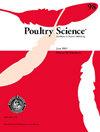Xylooligosaccharide interferes with the cell cycle and reduces the antibiotic tolerance of avian pathogenic Escherichia coli by associating with its potential antimetabolic actions
IF 3.8
1区 农林科学
Q1 AGRICULTURE, DAIRY & ANIMAL SCIENCE
引用次数: 0
Abstract
This study aimed to probe if xylooligosaccharide (XOS) could act as an antimetabolite to impact the cell cycle and antibiotic tolerance of avian pathogenic Escherichia coli (APEC). We firstly measured the bacteriostasis of XOS against APEC O78 and its effect on the growth of APEC O78 growing on different medium. Afterwards, the effects of XOS on xylose operon activation along with the cell cycle and antibiotic tolerance of APEC O78 were analyzed. The results showed that XOS caused no inhibitory circle against APEC O78 and did not affect (P > 0.05) the growth of APEC O78 growing on LB medium. Besides, APEC O78 was unable to grow on M9 medium (carbon-free) added with XOS. However, XOS exerted a similar role as xylose in increasing (P < 0.05) the expression of certain xylose operon genes including xylose isomerase (XylA)-encoding gene (xylA) and xylose-binding periplasmic protein (XylF)-encoding gene (xylF) in APEC O78. The molecular docking simulation revealed that the major monomer components (xylobiose, xylotriose and xylotetraose) of XOS had stable binding potentials to both XylA and XylF proteins of E. coli, as supported by the low binding free energy and the formation of considerable hydrogen bonds between them. The subsequent analysis showed that XOS altered certain cell cycle-related genes expression, especially elevated (P < 0.05) nrdB expression and decreased ihfB expression to a degree. Moreover, XOS played a similar role as 2-deoxy-glucose (a glucose analogue serving as a typical antimetabolite) in lowering (P < 0.05) the number of ampicillin-tolerant APEC O78. Collectively, XOS had no direct bacteriostasis against APEC and could not be metabolized/utilized by APEC O78. However, it might become an analogue of xylose and then activate xylose transport- and metabolism-related proteins in APEC O78, thus functioning as a potential antimetabolite and exerting antimetabolic actions. This could at least partially interpret the observed roles of XOS in interfering with the cell cycle and diminishing the antibiotic tolerance of APEC O78. The above findings expand the knowledges about the functions of XOS and provide a basis for exploring novel strategies to reduce the antibiotic tolerance of APEC.
木寡糖干扰细胞周期,并通过与其潜在的抗代谢作用相关联,降低禽致病性大肠杆菌对抗生素的耐受性。
本研究旨在探讨木寡糖(XOS)能否作为一种抗代谢物影响禽致病性大肠杆菌(APEC)的细胞周期和抗生素耐受性。我们首先测定了 XOS 对 APEC O78 的抑菌作用及其对 APEC O78 在不同培养基上生长的影响。随后,我们分析了 XOS 对木糖操作子活化的影响,以及 APEC O78 的细胞周期和抗生素耐受性。结果表明,XOS 对 APEC O78 没有抑制作用,也不影响在 LB 培养基上生长的 APEC O78 的生长(P > 0.05)。此外,APEC O78 无法在添加了 XOS 的 M9 培养基(无碳)上生长。然而,XOS 在增加 APEC O78 中某些木糖操作子基因(包括木糖异构酶(XylA)编码基因(xylA)和木糖结合周质蛋白(XylF)编码基因(xylF))的表达量(P < 0.05)方面的作用与木糖相似。分子对接模拟显示,XOS 的主要单体成分(木糖、木糖三糖和木糖四糖)与大肠杆菌的 XylA 和 XylF 蛋白都具有稳定的结合势能,其结合自由能较低,且两者之间形成了大量氢键。随后的分析表明,XOS 改变了某些细胞周期相关基因的表达,特别是在一定程度上提高了 nrdB 的表达(P < 0.05),降低了 ihfB 的表达。此外,XOS 在降低(P < 0.05)氨苄西林耐药 APEC O78 数量方面的作用与 2-脱氧葡萄糖(一种作为典型抗代谢物的葡萄糖类似物)相似。总之,XOS 对 APEC 没有直接的抑菌作用,也不能被 APEC O78 代谢/利用。不过,它可能成为木糖的类似物,然后激活 APEC O78 中与木糖转运和代谢相关的蛋白质,从而作为一种潜在的抗代谢物发挥作用。这至少可以部分解释所观察到的 XOS 在干扰细胞周期和降低 APEC O78 抗生素耐受性方面的作用。上述发现拓展了人们对 XOS 功能的认识,为探索降低 APEC 抗生素耐受性的新策略提供了依据。
本文章由计算机程序翻译,如有差异,请以英文原文为准。
求助全文
约1分钟内获得全文
求助全文
来源期刊

Poultry Science
农林科学-奶制品与动物科学
CiteScore
7.60
自引率
15.90%
发文量
0
审稿时长
94 days
期刊介绍:
First self-published in 1921, Poultry Science is an internationally renowned monthly journal, known as the authoritative source for a broad range of poultry information and high-caliber research. The journal plays a pivotal role in the dissemination of preeminent poultry-related knowledge across all disciplines. As of January 2020, Poultry Science will become an Open Access journal with no subscription charges, meaning authors who publish here can make their research immediately, permanently, and freely accessible worldwide while retaining copyright to their work. Papers submitted for publication after October 1, 2019 will be published as Open Access papers.
An international journal, Poultry Science publishes original papers, research notes, symposium papers, and reviews of basic science as applied to poultry. This authoritative source of poultry information is consistently ranked by ISI Impact Factor as one of the top 10 agriculture, dairy and animal science journals to deliver high-caliber research. Currently it is the highest-ranked (by Impact Factor and Eigenfactor) journal dedicated to publishing poultry research. Subject areas include breeding, genetics, education, production, management, environment, health, behavior, welfare, immunology, molecular biology, metabolism, nutrition, physiology, reproduction, processing, and products.
 求助内容:
求助内容: 应助结果提醒方式:
应助结果提醒方式:


